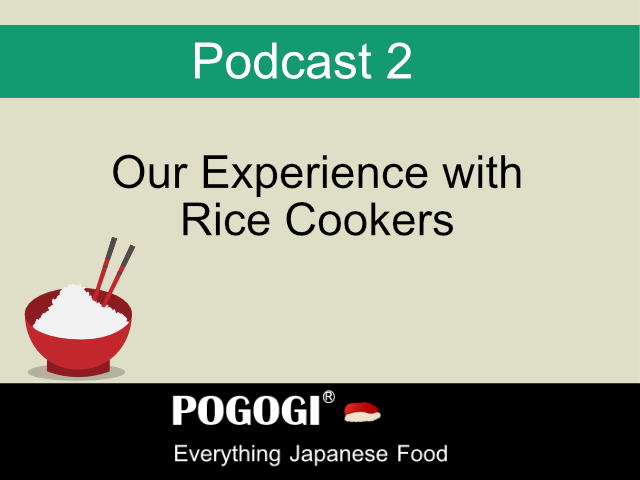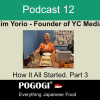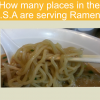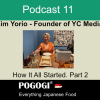Podcast 2 - Cooking Rice

PO and GI talk about rice cookers!
Podcast Transcript:
Right back with second podcast for Pogogi. Um, here we have PO myself joined with my partner in crime Gi. And what is the topic of today's podcast? Mr. Gi?
GI: Rice cookers!
PO: Awesome. One of the world's best inventions!
Did you ever have a rice cooker growing up?
GI: Yes. Um, we had several different types of rice cookers, and so I'm kind of familiar with all types and pretty excited to talk about it today.
PO: You had several rice cookers?
Yeah, because we use it so much that the only usually last maybe a year or two, and then we have to replace it. We ate a lot of rice have to say so. Cheap ones to expensive ones.
But I don't think we spent more than $100 to be honest,
PO: We only ever had one growing up.
GI: Wow what brand was that? I wonder.
PO: I can't remember. But it was like the classic old school with a white body, I think there was maybe, like a black lid or something like that.
But it was like a very old school, traditional looking rice cooker if you can call a rice cooker traditional looking. I don't know if we still have it. I should check with my mom and see if we still have.
GI: That is it has two handles on the side, right? That's the classic look and the lid.
PO: And you know what? We only ever used that one. I can't remember ever like replacing and if we still have it, it probably stills works.
GI: That's amazing. I'm trying, to remember?
Well, my parents spent upwards to $50 to $100 for rice cookers. And I mean, I think we've been through, like five through two decades. They have all been pretty good and rice cookers could go up upwards $200 to $300 which we'll talk about later. Some brands can be pretty pricey.
PO: Yeah for sure.
So I guess one thing that is really cool about rice cookers is that if you cook a lot of rice and you don't have a rice cooker and if you're just doing it like on a pot, like in a pot on the stove. You probably should consider getting a like a legit rice cooker because it's pretty much foolproof. I don't know if you feel the same way like you just you load it up with Rice.
Um, you hit play and you forget about it and it's done. It's like you can't screw it up. Well, I guess you could, but it's hard. I guess for those out there that don't have a rice cooker and there are cooking rice in a pot on a stove, you basically just open up the rice cooker.
There's a pot inside. I think, these days like the pots are non-stick. You just put one cup of rice and inside the pot are measurement lines.
If you put one cup of rice in, you fill the water up to one line, and that's it. If you put two cups of rice in you, fill it up to the second line. If you put three cups, you fill it up to the third line, and it doesn't get any simpler than that. You like I said, hit play.
And it takes what, 20 minutes? Usually?
GI: Yeah, 10 to 15 minutes and then usually just let it sit for a bit. But I have heard tips were once it is done, the switch pops up to tell you that it is done and that is when you should fluff it up with a fork.
Then you close it again and let it sit for another 10 minutes. This is for traditional rice cookers.
PO: Or use a plastic spatula or something. You can get some of those really cool like rice, um, scoops or whatever that are nonstick, so the rice doesn't stick all over them.
I've heard that too. Where you fluff up the rice and then you close the lid. Then you let it like steam for another 10 - 15 minutes and then you should be pretty good to go.
One thing that I heard and I've tried it for quite a while now is and I never did this before, but I would fill up the rice in the rice cooker or fill up the water in the rice cooker. Then I would let the rice sit in the rice cooker in the water for about 30 minutes before hitting play.
And I have noticed that that made a huge difference in the final product. I guess the rice absorbs a little bit of the water, and it just it makes the rice so much better. I mean it adds a little bit more time, but because rice cookers are so easy you just budget for another 30 minutes before you start cooking.
GI: You probably do this too but you should rinse the rice first. I used to do it right in the cooking pot like you could pull it out right from the main component. Then you can rinse. But I've been recently just doing it differently now. I've just seen it on videos and stuff. You just get one of those strainers and grab one of those baking measuring cups, which is becoming like different sizes. Like they come in a quarter cup, a third of a cup and so on
I just take a scoop of rice, fill it to the top and then put in my strainer and then just go to my sink and just give it a good couple of rinses. Then you can put it into the rice cooker.
How do you do it Po?
PO: (6:53) Like you said, take the pot out of the rice cooker, and I would kind of twirl the rice around in the water no more than three times. I've found that if like any more than three times, it's kind of unnecessary. And sometimes you don't wanna rinse the rise too much because you will lose like a little bit too much starch, which will affect the taste. Now what I do is on my on my faucet. You know, I have the smooth stream of steady water.
I'll use the spray mode and this mode will help agitate it, instead of using my hands. And I found that actually works really well.
PO: (7:40) I usually don't rinse it more than three times and some brands actually say not to rinse it. It's like it's already pre rinsed or something. I don't know how to do it, but actually, one of the brands that I eat a lot is it's a Japanese brand, and on the package, it says, like, don’t wash it, but I still I still like to rinse it once. I don't know, I think it's just a habit that I do.
GI: Yeah, I think it's important to like if you’re not familiar, especially when cooking rice other than white rice like brown rice or wild rice is just to look at the package and follow the instructions. Because the ratio for rice to water is different, so just keep that in mind.
You and I eat a lot of rice, so we do it by heart or out of habit. We don't even look at the package for instructions. But if you're not sure, just look at the package and just follow instructions.
PO: (8:42) yeah, that's a good point. Like I know with some like longer grain, like Chinese style rice like I'll put like if I put a cup in, I won't fill the water up to the one line. I'll fill it up to like the two line.
If I do one cup to the one line, it's likely to be too dry. But then the Japanese brand that I eat, I have to do one cup to one line.
Yeah, it is too much. Yeah, it's very dependent on the type of rice. There are so many different types of white rice, too. I forgot you mentioned that, but it's great that you brought that up for sure,
and some rice or more stickier than others such as Sushi. So you've got to really follow how much water it needs
Definitely much more convenient than cooking rice in a pot on the stove.
But ironically, like when I was growing up we always had a rice cooker and they're so damn easy to use. I never cooked rice in a pot on the stove and ironically, the first time I ever did that cooking rice in a pot on stove was when I was in Japan of all places
I was living in an apartment in Japan for about a month, and I didn't have a rice cooker. And so, um, someone showed me how to do it, and because there's inside like a typical like saucepan or pot, there are like no measurements on the inside.
And the technique that they showed me was just to fill the pot with water and when the rice is in there, you then fill it with enough water so that if you dip your finger into the pot of rice. The tip of your finger should be touching the surface of the rice. As long as the water reaches that first knuckle of your finger, then you're good.
And then so that's how you know you have enough water. Once the water comes to a boil, turn the heat down to basically a simmer. Like the lowest heat level, put a lid on it and let it steam for about 15 minutes, and then you're then you're pretty much good.
And I was super freaked out the first time I tried it because I thought it was going to burn the crap out of it. And I didn't know how it was going to turn up because like that to me, cooking rice in a pot on the stove like that. To me, that was weird. You can't do this in a rice cooker, but it turned out perfectly.
GI: (11:40) I’ve seen chefs use the stove top before using a pot.
PO: I guess the only difference is that, as opposed to rice cooker, you have to watch it. You have to pay attention to it, whereas when you use a rice cooker you may forgot you have rice in there, and then it doesn't matter, like it's just stays in there.
GI: Have you ever add anything to your rice cooker while it's cooking? Because I've seen people putting butter, a stick of butter in it. Even sausages things like that.
PO: I think that's the beauty of the rice cooker because, like you can use it to cook rice. But you can get pretty creative, and you can actually cook other food in it. Then by the time your rice is done, your other ingredients will steamed as well, depending on what your other ingredients are. Oftentimes, much of your meal can be done at the same time as your rice.
So sometimes, depending on what I'm cooking, I'll swap out the water for like vegetable broth or chicken broth or beef broth or something for extra flavor.
Sometimes I'll throw in some spices, maybe some garlic, maybe ginger, maybe onions, maybe vegetables or whatever. Um, the vegetables are easy because, you know it doesn't take long to cook, but sometimes depending on what it is. Like if it's vegetables, depending on what kind of the vegetable then I might throw it in like towards the end so it doesn't get too mushy.
GI: I’ve seen people do with bok choy, which is a good one.
PO: Or sometimes I'll even wait till the rice is done and then put it in because it's still hot in there, right?
And so if I am leaving the rice in there for another 15 minutes after it's done cooking anyway. I'll use that extra 15 minutes to cook again, depending on what the ingredient is. I'll use that extra 15 to throw in the veg or whatever else.
GI: I think it might be interesting to use frozen vegetables. For example, if you had a frozen broccoli. That'd be a good way to just kind of throw it at the end because it doesn’t need a full steam.
Just needs like a light steam for any frozen vegetable. I have never done that before but I’m sure other people have experimented with it. This kind of popped in my head because I do have a lot of frozen vegetables my freezer.
PO: I've done that before, and sometimes what I've noticed is depending on what I'm adding to the rice, I have to adjust the water a little bit. Like at the outset or the next time if I do it, I take notice on how much water I need for the next time.
The other thing that it is nice, like adding things to the rice before you start cooking. Depending on the ingredients, it will infuse flavor into the rice, which is really nice.
And I've also tried the butter. But I won't do it in the rice cooker but I do it like after, unless I'm mixing the whole thing. It was kind of weird to me, that is adding butter to rice. But someone did it one time. You and I know we know him. We won't disclose his last name, but his name is Al, the meat guy.
GI: I know who you're talking about.
PO: And so the first time I've seen it done, he was like do you have any butter. And I was like, Yeah, and he's like, well can I have some. And he added it to his rice. And I thought it was like, really bizarre until I tried it myself. And it was fantastic. And in fact, um, in Japan, it's actually something that a lot of people eat. They'll have a steaming bowl of hot white rice. They'll put a good knob of butter on the top of it, and they'll let it melt and coat the rice, and they'll kind of mix it up a little bit. They'll add just a touch of soy sauce, and it's absolutely delicious.
GI: Wow, it's interesting, because in some of the Rice at my local grocery store and, as there's different brands, right?
So I'm reading the back, and many of them do say, well they mention it as an option. That is to put butter but I think at the start of the cooking, I don't know.
Maybe I got to look into that. But again, I'm just saying that they mentioned Butter.
PO: I think you gotta wait till the end. So I'm that thinking now, because it is too much water.
GI: Yeah, I've had butter on my rice before at the end, and I agree with you, it's just heavenly.
PO: I think you gotta wait till the end like once the rice is cooked before adding the butter. There is too much water. It won't coat the rice the same.
So by the way, if it sounds like I'm slurring, I'm almost done a full bottle of wine, so I apologize.
It is Friday and it's been a long week.
Rice cooker is also good for reheating rice. And this was funny because I never used to do this, but spending a little bit more time in Japan. I noticed that they would often just leave the rice in the rice cooker even into the next day. And it would just keep it warm like it wouldn't be cooking anymore. It would just on the warm feature.
GI: Yeah, I've seen that with certain rice cookers.
PO: And sometimes I've unplugged the rice cooker, so it's not producing any heat anymore. I've just left rice in the rice cooker and then the next day I will add just a splash of water. I will cook the rice as I was was going to cook rice from scratch again on, and just does a perfectly nice job of reheating the rice. That’s if you're not going to use it for fried rice.
GI: That's a great thing with you. Like you mentioned, that rice is so versatile especially if you have leftover rice. You could just stir fry it.
Stir-fry rice can be a nice snack or meal. I've done that many times since we tend to make more rice than I need. So any rice left over you can stir-fry the next day, which is easy.
PO: So have you tried that fried chicken and the rice cooker?
GI: No but I've seen on YouTube several times. It was done by several big you Youtubers and it looks really delicious. You have done it right? I think if you told me.
PO: I’ve tried it yes. When I saw it on YouTube, I was like, I don't know, that looks kind of kind of weird.
I think what they were trying to replicate, I could be wrong on this, but I think what they were trying to replicate was like the chicken rice, not fried rice, but chicken rice. Which I think Singapore does like a version of it.
Um, so anyway, what you do is you buy like fried chicken. In this case, I think it was it wasn’t from KFC, but it was some kind of other fried chicken. And so put the rice, but make sure I wash my rice. I think I did two cups of rice, so I filled it to the line.
And then what you do is you take the dark meat so because of that I the same and used only the dark meat pieces. Then you place the fried chicken so that it covered the surface. I didn't stack the chicken. I just place the chicken on top of the uncooked rice in the water. It just covered the surface. That, to me, was really weird. I was like, I don't know how this is going to turn out, but I guess the oils and the flavor and the things like that are infused into the rice kind of like we were talking about earlier.
Oh, and then the other thing I did, was I swapped out water and I use chicken broth instead. And then I covered the rice cooker. I hit play, and I just let it do its thing. About 15 to 20 minutes later, I opened the rice cooker. I'm like, oh, doesn't look too bad. Of course, the fried chicken wasn't crispy anymore, but it wasn't the point, right?
So at that point, once the rice was done, I took the chicken pieces out, shredded the skin and meat off of the chicken. Then I added the treaded meat and skin back into the rice and I mixed it up with some green onions. Like, dice up green onions.
Then I tasted it, and the only thing I found it needed was a bit of soy sauce. It needed either a little bit more soy sauce or salt, like one of the other. So I ended up just add a little bit more soy sauce, then a little bit of white pepper and maybe a touch of garlic powder. Oh and also be little bit of onion powder and it was absolutely delicious. Like it was ridiculous!
GI: That sounds really good and delicious and yeah like I said, I’ve seen it on some of the YouTube video where everything just looks moist. I don't know if that is right term to use but it was or it looked very, very tender and very flavorful.
PO: What do you think? Like cheap versus expensive rice cookers. What's your take?
GI: (21:45) I've been using cheap. When I first moved out of my parent's place, I had a hand me down cheap one for 10 bucks. I think it was a tiger brand, and it did it a great job. I had no problem, and it made enough for up to one or two people. But I encounter other brands from visiting other friends and family members. They had the higher end models, which I could talk about quickly.
There are two top brands that are fairly expensive. The ones that we were talking about earlier are in the $10 or $20 ranges which are the traditional ones. These ones are fantastic it will get the job done.
But there's some rice cooker that are upwards of $200-$300.
If you looked up on any other websites these two will pop out in your searches for the best rice cooker. I'm probably pronouncing the name incorrectly, but it is called zojirushi.
There are two different versions of this rice cooker, one has the capacity of 5.5 cups of rice and the other one is 10 cups. I believe the one that has the capacity of 10 cups cost around $300.
This unit has different modes on it and it is very easy to. You can do brown rice, and there is a specific mode just the brown rice.
What is great about this rice cooker is that there is a warm mode where you can keep rice up to several days. Apparently, according to the FDA you can hold food indefinitely if it's above 140 degrees F or 60 degrees Celsius. So if it is at that temperature, which the rice cooker has that mode, you can keep the rice indefinitely.
But I've from what I'm reading it, like you wouldn’t go past four days, to be honest. Like even though it says it, indefinitely I wouldn’t go past four days and the rice is usually eaten by then anyways.
So that's a great thing about it so it can hold rice and it cooks a lot of rice. But that's probably good for families like it would be worth it for a single person.
The other top brand is $100 cheaper than the zojirushi. It is a Korean brand and it's called Cuckoo. It does pretty much the same thing as the zojirushi. It says that it can keep rice warm up to 12 hours, which is reasonable.
So that's a good option two of you when you spend less. But at the end of the day, I think you know any rice cooker like you asked, cheap versus expensive. I've been using a lot of cheap rice cookers, and I still have mine and I think its six years old and still going strong.
If you have a family, maybe go for the top of the line brand because then you could hold rice for a longer period.
PO: The one I have is national I think and I know Panasonic make some good rice cookers to.
Now that I think about it, I think the one we had growing up was made by National.
I think nationals is a Japanese brand. Okay.
But I mean, I’ve used my share of cheap rice cookers. And honestly, they all worked fine. Especially if you don't need all the bells and whistles, I don't know if it would necessarily be worth spending the extra cash unless it is a capacity issue. Even the cheap ones, I mean, they're all pretty much foolproof.
The thing I like best about the about cooking rice in a rice cookers is just the graduation lines that you get inside the pot. It couldn't get any simpler, right?
Like 1 to 1, 2 to 2, 3 to 3.
GI: I did see a video, though. It just kind of popped in my head. I saw that you video on YouTube where they compared a very expensive rice cooker versus a very cheap rice cooker. They did a blind test.
Yeah, and there was a slight difference. Apparently, it's not that much difference, but the more expensive one, I think it was Zojirushi, was actually fluffier. But the thing is, with the cheaper rice cooker I think it varies more. Like if you have a down pat like your habit of using a cheaper rice cooker, I think you will get the same consistency all the time.
I think it is easy to mess it up, but with a more expensive one, I think you might be more safer.
Maybe just, uh yeah, I think you're right.
PO: Like I think you're right. If you get a cheaper one, you could just once you kind of get the feel for it. You can tweak it and get a good finished product.
GI: Whereas the more expensive ones, it's always pretty standard making rice. But they both said that, I mean the two people testing the rice, liked the rice from the more expensive rice cooker. But it wasn’t by much. Also they mentioned that the flavour was slightly different to. I don’t know but I think the fluffiness was the deciding factor.
At the end of the day would you spend $14 versus $300? The mentioned that individual as well to that point.
PO: How much rice you eat, right?
Well, on that note, I think we're rolling up on our 30 minutes again here. So that was fun.
GI: Yeah, it was interesting topic.
PO: We’ll see if we can get another one out next week. Alright! Signing off!





